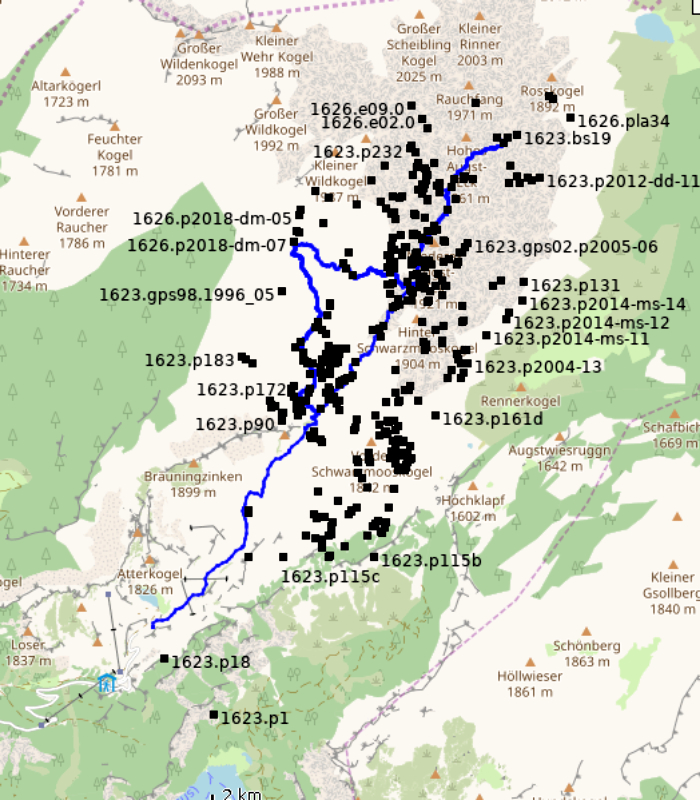
SAFETY. Everyone gets lost on the plateau. Don't get lost for long as this causes rescue plans to be initiated. So get this essential data onto your phone (or handheld GPS).
SAFETY. Turn on location tracking in Google Maps (or OsmAnd) before you leave the car park and share your location with someone you know at basecamp and also with someone you know at top camp. This will show your last known location if you walk into an area of bad signal.
We have a regularly-updated file of the wiggly tracks of the paths we regularly take: from Loser Alm car park to the col, top camp and Homecoming cave, and from top camp to Fisch Gesicht Höhle and to Tunnocks's, Balkonhöhle and Organhöhle.
[It also has the Austrian "kataster boundaries": these are not paths but separate areas with different mapping designations. These are the smooth, curved lines.] The file also includes all the cave entrances for the entire Schvartzmooskögel system (SMK).

Don't be misled by the apparent simplicity of the above tracks. The plateau is very broken and an almost unbroken extent of cliffs, holes and imapssable dwarf-larch scrub ("bunde" as it is known on expo). You can be 5m from the route and have lost it entirely.
Either
or
Try this link Wikilocs from where you can download a short version of the file (track and one waypoint at StoneBridge only) or a Google Earth trail (you need to create a Wikiloc account first and be logged-in when you click on this). Or here is another direct download link.
The most recent 2019 GPX file can be downloaded from here: essentials2019.gpx (596K).
Phones have a problem with a simple link like that.
This is where it gets tricky because every device and phone app does this differently.
This should work the same way whether you have an iPhone or an Android phone.
We do not have a recommended app as there is nothing we have found which quite does quite what we need. We are using www.gpsessentials.com and OsmAnd so try one of these first. If you discover a good app, tell everyone about it.
Visit the www.gpsessentials.com website and read the manual (top left, on the menu bar: "Manual") for how to do this. Except that the manual doesn't tell you.
The OsmAnd documentation says:
More documentation on this to follow...
Connect the GPS device to your laptop (or the expo laptop) using the USB cable. A folder will open on the laptop showing the contents of the device. You will see a subfolder called "GARMIN". Open the folder "GARMIN" and copy the file essentials.gpx which you downloaded into that folder.
These need the Garmin communication protocol to import cave entrance locations (waypoints) and paths (tracks). You can't do it by simply copying files. This means that you need special software on your laptop in addition to a USB cable that connects your laptop to the Garmin device.

Once you have the right cable and connected your handheld to your laptop:
We create a new version of this essential GPS data during expo and as expoers discover new entrances and devise new routes to reach them.
To regenerate the most recent version which contains the cave entrances discovered during expo you will need to ask someone who is competent in logging into the server and running scripts.
The data is in the version control system repository ::loser:: in
loser/gpx/and is generated from the survex data by a script. It is best to do this on a laptop which has the entire ::loser:: repo downloaded onto it (e.g. the expo laptop) rather than on the server itself as the server can run out of memory doing this.
The most recent track data will have been uploaded by an expoer into e.g.
expofiles/gpslogs/2019/MichaelSargent/col-to-homecoming-msargent-2019-07-14_18-38_Sun.gpx
and this will need to be hand-edited into script-generated essentials.gpx file.
The most recent 2019 GPX file can be downloaded from here:
essentials2019.gpx (596K).
This is actually entirely hand-edited from original tracks. The only survex data it uses is the entrances waypoints which are exported
by the script which has been hand-edited in. It also has the kataster boundaries hand-edited in.
Last year's (17 July 2018) can be downloaded from here : essentials.gpx (190K). (This is a symlink to loser/gpx/essentials.gpx).